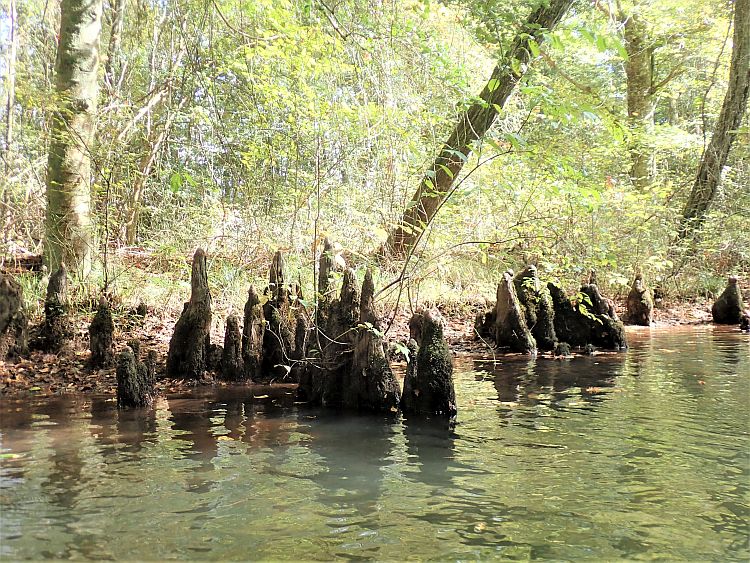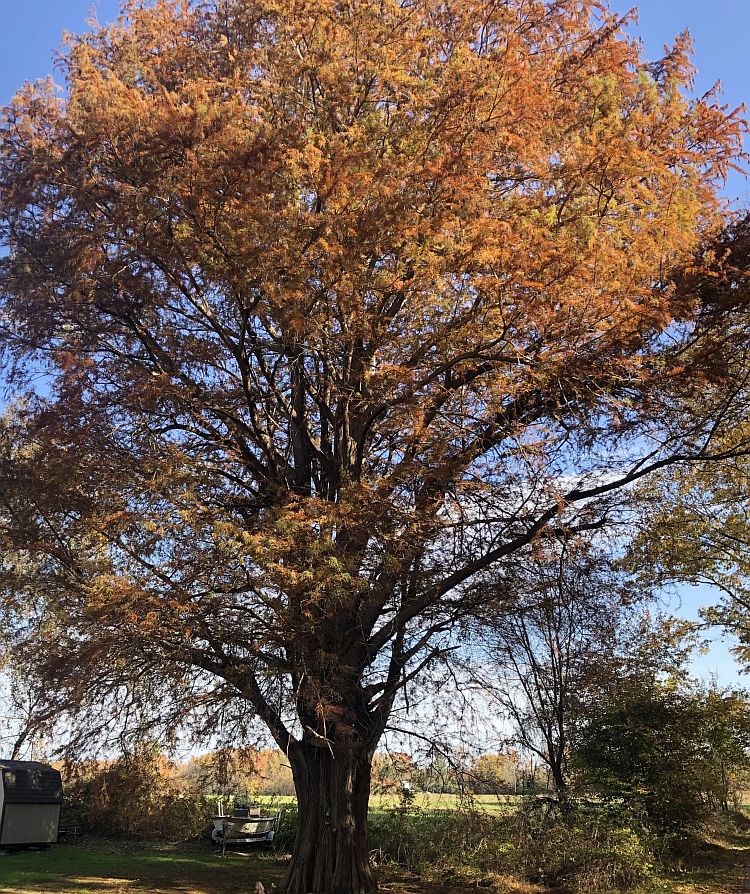Baldcypress: Towering Virginia Icon
By Betsy Washington, Northern Neck Chapter
Baldcypress, Taxodium distichum, our November Plant of the Month, is an unforgettable sight all year. But in late fall when its soft foliage turns vibrant shades of copper-orange, it lights up the entire landscape. These trees are called “bald” because, unlike most other conifers, they are deciduous and lose their needles in winter. Baldcypress are an icon of our southern swamps and coastal areas and can reach towering heights of over 100’ (145’ is the Virginia record). Adding to their impressive stature, they have huge, buttressed trunks that flare out at the base; the largest diameter tree known is 17’ in diameter.
In the wet, swampy soils they prefer, the trunks are usually surrounded by a host of knobby, conical “knees” looking like gnomes or “bark-covered stalagmites”. The cypress knees can be more than 3’ in height, but the reported record is an astonishing 14’. Scientists believe these knees help anchor these massive trees in the swampy soils although this is still open to debate. Their bark is warm cinnamon-brown and exfoliates in shaggy vertical strips. Like all conifers, Baldcypress have cones held at the tips of their drooping branches but even these are distinctive. The cones are short-stalked and round, up to 1-1/2” wide, green to purple in color, eventually turning brown with 5 to 10 wrinkled scales.
Baldcypress naturally occur in coastal areas from southern Delaware south to east Texas and up the Mississippi River valley. They are found in swamp forests and occasionally seepage swamps that are flooded for protracted periods of time, and are locally common in the Coastal Plain of Virginia including the Northern Neck.
Joan Maloof, founder of the Old Growth Forest Network, says of Baldcypress, “They are the Redwoods of the East…and the longest-lived trees we have.” One recently discovered tree on the Black River in North Carolina documented at an astonishing 2,624 years old! Virginia’s own Cypress Bridge Swamp Natural Area Preserve has many ancient Baldcypress that are over 1,000 years old. Along Dragon Run in Middlesex County, measurements of one large Baldcypress suggests an age of 800 to 1,200 years. Entering a cypress swamp on any day is an unforgettable experience, with the massive buttressed trunks rising high overhead creating nature’s own spectacular cathedral.
Surprisingly, Baldcypress are easy to grow in average, moisture retentive soils in full sun to part shade. Although they naturally prefer acidic, alluvial soils rich in organic matter, they are adaptable and have been used successfully in a wide range of sites from parking lots to large parks to rain gardens. They are at their best in damp to wet soils along streams, ponds, or swamps where they are especially beautiful planted in groups and draped with Spanish Moss, as in nature and where their surreal beauty is reflected in the water. Here they will also improve water quality and provide flood control. Baldcypress are tolerant of extended flooding as well as slightly tolerant of salt and deer resistant.
The wood of older Baldcypress is dense, straight grained and very decay resistant and has long been used as building material, leading to the decimation of many of our oldest swamps. They are also important for wildlife, providing seeds for wood-ducks and other waterfowl, evening grosbeaks, turkeys, prothonotary warbler and the yellow-throated warblers that search for insects in the Spanish moss festooning their branches. They provide nesting habitat for a variety of birds as well as frogs.
Baldcypress are best planted while dormant in late fall or early spring. Consider adding one or a group of these magnificent trees to your own property, knowing that these trees will outlive you and your grandchildren, becoming more spectacular with great age.
Baldcypress (Taxodium distichum) was the Northern Neck Native Plant Society November 2021 Plant of the Month.






Wow! Mother Nature never ceases to amaze me. I have spent most of my 80 years in Colorado, California, and Oregon, hiking in the Rockies, Sierras, and Cascades. I believed that, basically, there were two types of trees, conifers and deciduous. And never the two shall meet. When I saw the Bing wallpaper of the day with the baldcypress in Georga, I not only started towards the rabbit hole, I ran to it at full speed, and dove in. An hour later I ended here. In my youth, I was in the navy and based in Norfolk. It is too bad I never took the time to appreciate the Virgina flora.